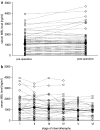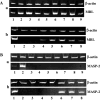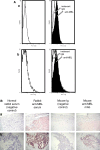Mannan-binding lectin (MBL) in women with tumours of the reproductive system
- PMID: 17131120
- PMCID: PMC11031024
- DOI: 10.1007/s00262-006-0250-7
Mannan-binding lectin (MBL) in women with tumours of the reproductive system
Abstract
Mannan-binding lectin (MBL) is an important factor of innate immunity contributing to the clearance of microorganisms. Recently, an antitumourigenic role of MBL has been suggested. We investigated mbl2 genotypes, MBL concentrations, and MBL-MASP-2 complex activity in patients with ovarian cancer. The expression of both mbl2 and masp-2 genes were investigated in ovarian tissue sections. Additionally, samples from patients with other malignant and benign tumours of the reproductive tract were tested. A significantly higher incidence of MBL deficiency/insufficiency-associated genotypes was found among patients with malignant disease compared to age-matched controls. Unexpectedly, no differences in median MBL level or MBL-MASP-2 complex activity were found between the groups. This was partly a reflection of higher MBL concentrations and MBL-MASP-2 activity in cancer patients compared with healthy women carrying corresponding genotypes. MBL-specific mRNA expression was detected in several normal and malignant ovarian tissues, as well as in ovarian epithelial cell lines. Intracellular staining with MBL-specific antibodies demonstrated the presence of MBL in ovarian cell lines, and in normal as well as malignant ovarian tissue sections. In contrast, MASP-2-specific mRNA expression was detected only in the ovary tissues of patients with malignant disease. No significant changes in MBL concentration during 3 months of chemotherapy were noticed. MBL was detected in ascites and in the fluid of benign ovarian cysts. Our findings may reflect anti-tumourigenic activity of MBL protein which might suggest potential therapeutic application. However, it cannot be excluded that mbl-2 mutant alleles may be in linkage disequilibrium with an unidentified tumour susceptibility gene(s).
Figures





References
-
- Bellavia D, Frada G, Di Franco P, Feo S, Franceschi C, Sansoni P, Brai M. C4, BF, C3 allele distribution and complement activity in healthy aged people and centenarians. J Gerontol A Biol Sci Med Sci. 1999;54:B150–B153. - PubMed
-
- Bergmann OJ, Christiansen M, Laursen I, Bang P, Hansen NE, Ellegaard J, Koch C, Andersen V. Low levels of mannose-binding lectin do not affect occurrence of severe infections or duration of fever in acute myeloid leukaemia during remission induction therapy. Eur J Haematol. 2003;70:91–97. doi: 10.1034/j.1600-0609.2003.00012.x. - DOI - PubMed
Publication types
MeSH terms
Substances
LinkOut - more resources
Full Text Sources
Other Literature Sources
Medical
Miscellaneous

